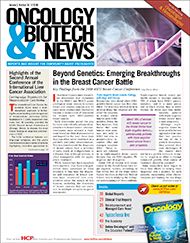Publication
Article
OBTN
FDA Approves First Anti-Nausea Patch for Patients in Chemotherapy
Author(s):
ProStrakan Group plc, announced it had attained FDA approval to market Sancuso in the United States. The company describes Sancuso as the first and only anti-nausea and vomiting agent formulated for delivery via a transdermal patch, designed specifically to prevent these adverse effects in patients with cancer who are undergoing chemotherapy.
Click here to view as PDF.
ProStrakan Group plc, a European company that has its US headquarters in Bedminster, New Jersey, announced it had attained FDA approval to market Sancuso (granisetron transdermal system) in the United States. The company describes Sancuso as the first and only anti-nausea and vomiting agent formulated for delivery via a transdermal patch, designed specifically to prevent these adverse effects in patients with cancer who are undergoing chemotherapy.
These patients frequently cite chemotherapy-induced nausea and vomiting (CINV) as greatly feared adverse effects. In addition to the social and emotional toll of CINV, untreated CINV can lead to dehydration, malnutrition, and treatment delay or discontinuation. Despite newer chemotherapy agents designed to reduce the incidence of these unpleasant effects, CINV continues to be a major issue for patients. Some patients believe that these unpleasant symptoms are unavoidable consequences of chemotherapy and suffer alone, at home, outside the supervision of healthcare professionals.
The Sancuso patch attaches to the skin with a thin layer of adhesive. Once applied, the patch releases granisetron—an established inhibitor of nausea and vomiting—slowly and continuously. The drug enters the patient’s bloodstream transdermally. ProStrakan says that a single application of the Sancuso patch provides up to 5 consecutive days of relief from nausea and vomiting in patients receiving a moderately or highly nausea-inducing chemotherapy regimen.
The FDA approved Sancuso for the prevention of CINV based on the positive outcome of a multicenter phase III randomized double blind, double-dummy controlled study that compared the efficacy, tolerability, and safety of Sancuso with oral granisetron (2 mg once daily). The trial enrolled 641 patients who were undergoing moderately or highly nauseainducing multi-day chemotherapy. The trial’s primary end point was to achieve complete control of CINV. Researchers defined complete control as no episodes of vomiting or retching, no more than mild nausea, and no need to take rescue medication from administration of the first dose of Sancuso until 24 hours after the final dose of chemotherapy.
Sancuso met this end point and was as effective as oral granisetron. It was also well tolerated. Only 8.7% of patients experienced adverse reactions that investigators categorized as drug-related. The most common adverse reaction was constipation. Some mild reactions were reported at the application site, but they did not result in treatment discontinuation and were comparable in number to the incidence of skin reactions with placebo. “We believe that Sancuso, used within an individualized approach to therapy, can help lift the burden that CINV can have on both patients and health-care providers,” said company CEO Wilson Totten, MD.
